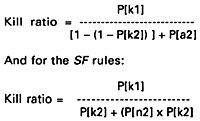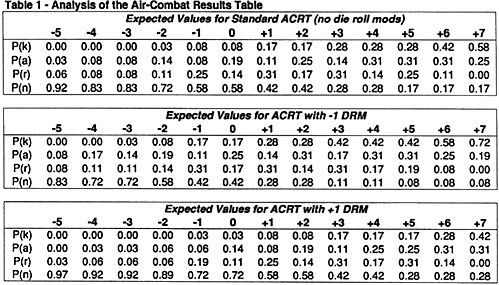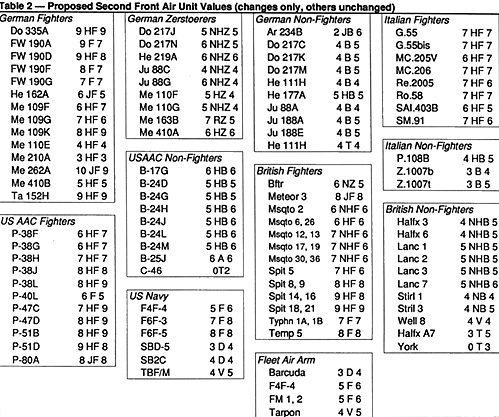Second Front (SF) will fill out the mid- and late-war air inventories for the Allied player. Given the scale of air assets available to the Allied player in the game, this is of more than just passing interest. Indeed, the sheer quantity of available Allied air units results in them becoming a primary contributor to the Allied player's combat power. For SF more than any other Europa game, the air units, their ratings, and their interactions have moved to center stage.
Given this level of influence, it is especially important that the airunit values and mechanics support a sustained air campaign whose outcome makes sense in terms of history. For a long- term game such as SF, this really boils down to the relative losses of Group Allowance (GA) compared to the overall ratio of available GA. For example, based on the GA totals given (to date) in the SF playtest, the Allies have a 2.8 to 1 advantage in GA (not counting the Fascist Italian forces).
This means that if the overall loss rate in air units is better than 2.8 to 1 for the Germans over many turns, then the Luftwaffe is getting stronger relative to the Allied air forces- they're "winning". If the loss rate is less than 2.8 to 1 in the Germans' favor, then the Allied air forces are "winning".
The air combat results table (ACRT) readily lends itself to a statistical analysis for probabilities of kill (P[k]), abort Mal), return (P[r]), and no effect (P[n]). These are shown in Table 1. From these numbers, kill ratios can be calculated using various algorithms. Fundamentally, the kill ratio algorithm is based on the ratio of the P[k], P[a], P[r], and P[n] terms, where the base value for each term is found by taking the appropriate difference of the offense and defense values for each unique aircraft pairing and using them to determine the appropriate likelihood of the outcomes.
Still open for discussion is what different weighting factors should be applied to each term, but I think two weightings are particularly appropriate. The first, and most simple, is to assign the P[kI values a relative level of 1, and all other terms are 0. This kill ratio is expressed:
- Kill ratio = P[k1] + P[k2]
You might think this too simplistic, but the game mechanic that determines GA losses uses exactly this weighting. Therefore, kill-ratios based on this should track the GA loss ratio over a sustained campaign.
A smoother kill ratio expression is given by weighting the terms as follows, which better represents a many-on-many engagement, assuming that R and results do not produce casualties noticeable at the Europa scale.
- Relative weighting of P[k] 1
Relative weighting of P[a] 0.5
Relative weighting of P[r] 0
Relative weighting of P[n] 0
![]() The kill ratio expression is
then given by the following
expression (at right):
The kill ratio expression is
then given by the following
expression (at right):
To some extent, this expression is implemented in Scorched Earth (SE), where two consecutive aborts in air combat will kill a unit.
I have these expressions loaded into a spreadsheet, and have worked up tables showing kill ratios for the most important aircraft in the game, given the air combat values used in the SF playtest. One of these is included as Table 3 using the air-combat values given in the SF playtest. Each row in the table has paired selected aircraft types, with the columns showing kill ratios for many-vs.-many and one-vs.-one engagements.
I have also included the kill ratios for 2-vs.-1 engagements (where the 2-vs.-1 case is always 2 Allied vs. 1 German) since this situation often occurs given the disparity in force levels. This adds two more columns, one using an expression based the SF playtest rules and one using the Scorched Earth rules.
 For the SE two-vs.-one cases, I
used the following approximation (at right):
For the SE two-vs.-one cases, I
used the following approximation (at right):
I did this only for fighters. Bomber vs. fighter combat is almost always 1-on-1 in the game since few players will fly a mission if multiple fighters can hit the bombers. If a resulting kill ratio was less than 1, 1 added the inverse of the number to clearly show the favorable kill ratio for the other aircraft. So what does this all mean?
Well, I think what is required to put the numbers in perspective is to compare them to the ratio of the Group Allowances available to both sides (about 2.8 to 1). What I think this means is that the German player will not fly Me`109s and Me110s against Allied fighters, since they won't get good kill ratios, and that the FW 190s, which average better than a 4-to-1 kill ratio will be used to attrit the Allied air forces. Given enough replacement units, FW 190s, even if outnumbered 2.8 to 1, will destroy the Allied air forces.
Our playtest results confirm this trend, with the usual observations that a defending air force with patrol attacks, scrambles, the ability to decide not to intercept if things are not favorable, and the ability to choose the aircombat matchups in an interception, will achieve better results than these averages. In short, I believe the values as they stand will result in a proportional loss of strength by the Allies that is not historically justified. A symptom of this is the enormous inflation of the combat values of late-war fighters with respect to some mid-war types like the Me 109G.
The best documented air combat kill ratio in all of WWII is for the Grumman F6F Hellcat, at 19:1. Yet even this extraordinary ratio is versus all aircraft types. Thus, fighter-vs-fighter kill ratios of 10:1 and higher at the group level between, say, Me109Gs and P-47Ds appear to be totally unjustified and not grounded in reality.
Bringing down the Allied values from outrageous to just superior creates a problem if the German late- war air units are not also adjusted.
Accordingly, I propose some modified values, as shown in Table 2 (note that aircraft not included here have not been changed). The resulting kill ratios based on these proposed values are included in Table 4 for comparison with the numbers from Table 3. As can be seen, there are no more kill ratios of infinity for fighter-vs- fighter pairings. The Germans still retain an overall superiority even beyond what is shown since German air units represent Gruppen of 40 planes compared to American Groups of 48.
In addition, I have devised some new wrinkles to the air-combat mechanics which solve some other problems. The first of these was an attempt to cast the Mel 10 and its variants into a usable asset against the heavy bombers, which they were (if no escorting fighters were present). The best way to do this seemed to be to create a bomber-killer aircraft type, which Jason Long has suggested be designated Z for Zerstoerer (Destroyer). A type Z air unit receives a -1 to its die roll on the ACRT to both B and HB unit types, unlike the standard type F which receives the -1 only for type B. A type B returns fire at a +1 DRM, exactly as if it were shooting at a fighter.
The type HB returns fire with no DRM modifier. Type Z air units have no DRMs in combat with type F units. Table 4's values assume this modification, and I believe it represents the twin-engine heavy fighters more accurately. The other changes are intended to be used with the strategic air campaign, and so is not needed directly for SF. One change is to identify the specific aircraft types that were capable of retaining high performance at high altitudes. For the missions defined in Europa games to date, few or none would be flown at high enough altitudes for this to make a difference. For the strategic air war, however, operating altitudes of 25,000+ feet were outside the performance envelope of many aircraft, such as P-40s, FW 190As, Typhoons, etc.
I suggest extending the H designation to aircraft whose high-altitude capability warrants it. It can be assumed that missions involving type HB units are flown at high altitude. All other missions are assumed to be flown at "normal" altitudes. For air combat during a high-altitude mission, an air unit without an H type designation has a +1 DRM to its roll on the ACRT. A H type unit receives a -1 DRM to its roll if it fires on a non H type unit. The Fw 190A kill ratios against type HB units in Table 4 assume this is used. All other kill ratios in Table 4 assume the combat is at "normal" altitude.
Type J and R units are automatically considered to be a type H unit. One other tweak seems to be needed for the strategic air war. With the proposed values above, the P-51s flying from England will be competitive at extended range (say over Berlin) with both Me109Gs (both at 7F6 after modification for range) and the FW190As (with the +1/-1 DRMs for the Fw190 as a non-H unit).
However, history suggests the P- 51 should retain superiority rather than just being competitive. But when the FW 190Ds arrive, the England-based Mustangs will be in bad shape. An option to resolve this is to consider how the escorting missions for the Oth Air Force were flown. The fighters would proceed to the European coast using the fuel in their drop tanks (the Germans had insufficient assets for over-sea interceptions, and the Allied radar and communications net could guarantee a clear approach). In the game, this can be easily done by allowing escorts to fly missions as if their point of departure is a coastal hex.
Thus, the first hex counted against their range allowance is the first land hex outside of England. This also looks as if it provides a better fit for the historical P-47 escort ranges.
Patrol Attacks
A concluding recommendation is to modify patrol attacks. I can think of no other rule in Europa that is so prone to either being ignored or modified by a plethora of house rules. For what it's worth, I recommend making patrol attacks and interception missions mutually exclusive. A patrol attack would then become an interception mission carried out at a low level of effort capable of disrupting a mission but not capable of causing casualties noticeable at the Europa scale.
Also, escorted bombers may not be affected by patrol attacks until all escorting fighters are patrolled. In summary, this article is an attempt to provide a means of evaluating the air unit ratings using a clearly defined objective criteria.
Given the lack of accurate kill-ratio data at the Group level, I was forced to subjectively assign many of the values in Table 2. However, the kill ratios of the proposed values seem more realistic. I hope this becomes a useful point of departure for a final rating of air-unit values. If so, I will work up a corresponding article for the Eastern Front units and their values.


An Analysis of the Second Front Air-Combat System A New Look at a Familiar Friend
Back to Europa Number 22 Table of Contents
Back to Europa List of Issues
Back to MagWeb Master Magazine List
© Copyright 1991 by GR/D
This article appears in MagWeb (Magazine Web) on the Internet World Wide Web. Other articles from military history and related magazines are available at http://www.magweb.com